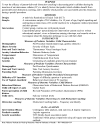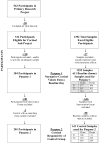Normative salivary cortisol values and responsivity in children
- PMID: 19171296
- PMCID: PMC2650745
- DOI: 10.1016/j.apnr.2007.04.009
Normative salivary cortisol values and responsivity in children
Abstract
This was a descriptive study on normative salivary cortisol values and responsivity to a hospital clinic visit and an intravenous (IV) procedure in children. The study presented was a subproject of a primary research study that examined parents coaching their children requiring an IV placement in the use of distraction. One measure of child response in the primary study, salivary cortisol, was included to further our understanding of children's physiologic response to stressful and painful stimuli. Salivary cortisol samples were obtained from 384 children aged between 4 and 10 years upon arrival to the clinic and 20 minutes after their IV insertion. Baseline samples were collected at home on a typical day for the children. Data from baseline samples were used to establish normative values between 8:00 a.m. and 3:00 p.m. on a nonprocedural day. Results demonstrate that normative cortisol levels in children follow a pattern similar to the circadian pattern in adults, decreasing from early morning to mid afternoon. Matched samples from control group children were used to evaluate group responsivity. Salivary cortisol levels on the baseline day were lower than those obtained during the day of the procedure and tapered over time as expected (-8.7% +/- 6.7%, p = .431). Cortisol levels on the clinic day increased from baseline and increased further in response to IV placement (15.7% +/- 6.7%, p = .023). A Location x Time interaction was significant (p = .019). Findings demonstrate that salivary cortisol is a useful measure of stress response that can be used to evaluate intervention effectiveness.
Figures



References
-
- Bartels M, de Geus EJ, Kirschbaum C, Sluyter F, Boomsma DI. Heritability of daytime cortisol levels in children. Behavior Genetics. 2003;33:421–433. - PubMed
-
- Bozkurt P, Kaya G, Yeker Y, AltIntaS F, Bakan M, HacIbekiroglu M, et al. Effectiveness of morphine via thoracic epidural vs intravenous infusion on postthoracotomy pain and stress response in children. Pediatric Anesthesia. 2004;14:748–754. - PubMed
-
- Bruce J, Davis EP, Gunnar MR. Individual differences in children’s cortisol response to the beginning of a new school year. Psychoneuroendocrinology. 2002;27:635–650. - PubMed
-
- Charmandari E, Tsigos C, Chrousos G. Endocrinology of the stress response. Annual Review of Physiology. 2005;67:259–284. - PubMed
-
- Chen E, Craske MG, Katz ER, Schwartz E, Zeltzer LK. Pain-sensitive temperament: Does it predict procedural distress and response to psychological treatment among children with cancer? Journal of Pediatric Psychology. 2000;25:269–278. - PubMed
Publication types
MeSH terms
Substances
Grants and funding
LinkOut - more resources
Full Text Sources
Medical

